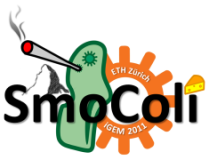Team:ETH Zurich/Modeling
From 2011.igem.org
| Modeling Overview |
| |||
| We created a computational model of our system in order to check whether our ideas might work in reality. We investigated questions such as for which range of acetaldehyde input we get a GFP band from the band-pass filter, or what the most suitable channel dimensions are in silico. Only afterwards we started with the actual experimental channel design. | ||||
|
Most of the model equations and parameters we took from existing literature, which is supported by biological data. For some of them, we had to make assumptions or small adjustments, so that they meet the biological conditions under which we create our system in the lab. First, we simulated the single cell model in MATLAB to see whether every module (sensor, band detector, filter) works properly. Most of the parameter manipulations and fine tuning of the system were done on the single sell model. Then, we used the COMSOL software to simulate diffusion of the toxic molecules to see whether a realistic gradient could be created. This is the point when we started to get some feeling about the channel dimensions. At the end, we combined the single cell model with the diffusion model to get the final (reaction-diffusion) model in COMSOL. By visualizing the diffusion and the movement of the GFP band, we saw that our system can actually work in practice. |
 "
"

